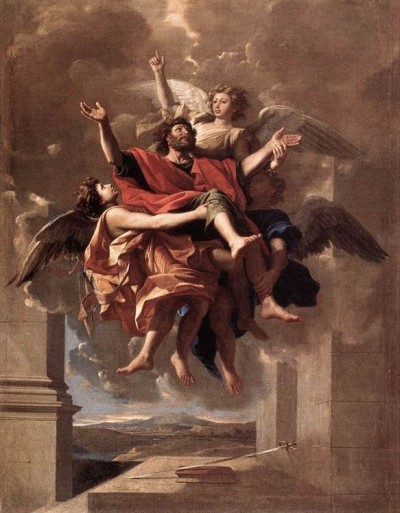From the Epistle of Sexagesima Sunday
 Nicolas Poussin, The Ecstasy of Saint Paul, 1649-50
Nicolas Poussin, The Ecstasy of Saint Paul, 1649-50
This glorious entanglement of arms and legs, both mortal and angelic represents Saint Paul’s rapture up to the third heaven. The lower angel on the right is supporting the Apostle under the knee, while the lower angel on right, whose face is shadowed, lifts him just above the ankle. The chief angel, situated above Saint Paul, is pointing upward as if to say, “Let us go up thither.” On the slab of stone at the bottom of the painting we see the bound book of Saint Paul’s Epistles and a sword. The sword represents the Word of God preached by the Apostle; it also prefigures his martyrdom.
And I know such a man
(whether in the body, or out of the body, I know not: God knoweth):
that he was caught up into paradise,
and heard secret words,
which it is not granted to man to utter.
For such an one I will glory,
but for myself I will glory in nothing,
but in my infirmities. . . .
I have no mind that anybody should think of me
except as he seeth me,
as he heareth me talking to him.
And indeed,
for fear that these surpassing revelations
should make me proud,
I was given a sting to distress my outward nature,
an angel of Satan sent to rebuff me.
Three times it made me entreat the Lord to rid me of it;
but He told me, My grace is enough for thee;
my strength finds its full scope in thy weakness.
More than ever, then,
I delight to boast of the weaknesses that humiliate me,
so that the strength of Christ may enshrine itself in me.
I am well content with these humiliations of mine,
with the insults, the hardships,
the persecutions, the times of difficulty I undergo for Christ;
when I am weakest, then I am strongest of all.
(2 Corinthians 12:3-10)
